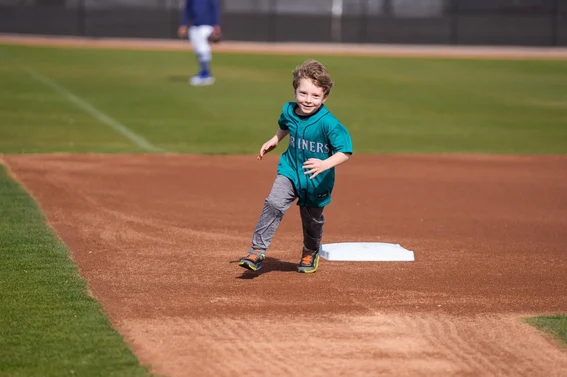BIG LEAGUE CARE
From cancer treatment to running the bases
By Kara Mason
October 2023
This summer, six-year-old Coleman Tawresey will go more than 12 consecutive weeks without a doctor’s appointment – something he hasn’t been able to do since being diagnosed with retinoblastoma when he was two.
It’s a welcome break for the kindergarten graduate and his family who now have more time to play, ride bikes, and enjoy the Seattle Mariners, who invited Coleman to hang out with the baseball team and run the bases at their season opener this year after Coleman beat his cancer for a third time.
“We’re feeling pretty good about remission,” says Coleman’s mom, Laurel Tawresey.
Scott Oliver, MD, associate professor of ophthalmology who directs the eye cancer program and is the chief of retina services at the Sue AnschutzRodgers Eye Center, treated Coleman for more than two years. He says Coleman’s experience is one of perseverance.
Retinoblastoma, an eye cancer that forms in the retina and most often occurs in young children, can result in blindness, loss of the eye, and even death. Coleman was ultimately diagnosed with tumors in both of his eyes, making the cancer even more challenging to treat. While he has reduced vision in one eye, his other eye sees perfectly, and he functions like any other kid.
Coleman underwent several rounds of chemotherapy, including intraarterial chemotherapy, which targets drugs directly at the tumor by threading a catheter through the femoral artery, past the heart and carotid artery, and into the artery that feeds the eye. Coleman also received radiation plaque therapy, laser topical therapy to eliminate cancerous seeds in the eye, and intravitreal injections.
PARENTS’ INTUITION
In 2020, Coleman, then two years old, was hitting his developmental milestones, Laurel says. There wasn’t any obvious indication he didn’t have much vision in his right eye. It wasn’t until an ear tube surgery and a follow-up screening that Coleman’s family started to suspect something was wrong with his vision.
One evening shortly after Coleman had failed the vision test and the family was awaiting a check-up appointment with a pediatrician, Laurel and her husband were playing with Coleman and noticed one of his pupils looked white.
“I remember thinking that is not normal,” Laurel recalls. “At that point we did what everyone does and Googled it. We found that you can take a picture with a flash, and it can show signs of retinoblastoma, so we got our camera and took a picture.”

Coleman Tawresey runs the bases before this year’s season opener at T-Mobile Park in Seattle. The Mariners invited Coleman to hang out with the team after beating retinoblastoma. Photo courtesy of the Seattle Mariners.
The next day Coleman was in an ophthalmologist’s office. Laurel says it wasn’t obvious that anything was affecting her toddler’s vision.
“He could drop kick a soccer ball, run, and climb, and do all of these things normally, so there wasn’t any indication to us that he didn’t have much vision in that eye,” Laurel explains.
REACHING REMISSION
“There are a lot of treatment options for retinoblastoma,” Oliver explains. “But there still isn’t a slam dunk treatment. It’s a disease that 96 to 98% of children in the U.S. survive, so it really becomes primarily about trying to save the eye and vision.”
While many treatments for various types of cancer are moving toward targeted therapies — which can single out a specific gene or protein — all the chemo therapies used to treat retinoblastoma are nonspecific.
On average, Oliver says it takes about a year to resolve retinoblastoma, but for Coleman it took more than two years. All the while, the boy was catching baseballs and riding his scooter, Laurel says. That gave her and Coleman’s family hope that Oliver wouldn’t have to remove an eye or that Coleman would lose vision.
“We have special tools to give patients a shot at keeping their eye,” Oliver says. “It’s a lot of work, and you have to be in it for the long haul.”
Now, Coleman is in remission for the third time and his prognosis is looking good.
To celebrate, the Make-A-Wish organization helped Coleman spend Opening Day at T-Mobile Park in Seattle, where he and his family now live.
Laurel says Coleman has remained a fun-loving kid.
“One thing that inspires me about my son is that in spite of it all, he still is a very kind and caring and goofy kid,” she says. “In the face of medical trauma, it wouldn’t be unreasonable or even uncommon for a kid to struggle with behavioral issues, aggression, anger, or extreme sadness. But he’s such a sweet boy."